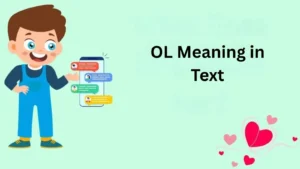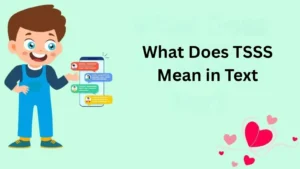Texting is a big part of how we talk today. Whether it’s a quick message to a friend, a post on social media, or a chat in a game, short terms like “MK” pop up all the time. MK usually means “okay” or “mmkay” in text messages, a casual way to agree or acknowledge something.
You might see it in a group chat, on TikTok, or even in a gaming lobby. Understanding slang like MK helps you keep up with fast-paced conversations and avoid confusion. It’s especially important for younger people or anyone active online, where new terms spread quickly.
Knowing what MK means can make your chats smoother and show you’re in the loop. This blog dives into what MK means, where it came from, and how to use it right in different settings.
Definition & Meaning
MK stands for “okay” or “mmkay” in text messaging. It’s a shorthand way to say you agree, understand, or acknowledge something without typing out full words. Think of it as a laid-back version of “OK.” It’s often used to keep conversations quick and casual, especially among friends or in informal settings.
Examples of MK in Use
- Friend 1: Wanna grab pizza tonight?
Friend 2: MK, sounds good! - Gamer 1: Meet at the spawn point in 5?
Gamer 2: MK, I’m there. - Sibling 1: Can you pick up milk?
Sibling 2: MK, on it.
MK is short, snappy, and conveys agreement or confirmation. It’s popular because it saves time and fits the fast pace of texting or gaming chats. You might also see it spelled as “mmkay,” mimicking a drawn-out, playful way of saying “okay.”
Background & History
The term MK likely comes from the phonetic sound of saying “okay” in a casual, drawn-out way, like “mmkay.” This pronunciation became popular in the 1990s, partly thanks to pop culture.
The character Mr. Mackey from South Park, who often said “mmkay,” helped spread this quirky way of saying “okay.” Over time, people shortened it to MK in texts to save time.
In the early 2000s, as texting and instant messaging grew, abbreviations like LOL, BRB, and MK became common. MK caught on because it’s quick to type and feels playful yet clear.
Today, it’s used across platforms like WhatsApp, Snapchat, and gaming chats like Discord. While it started in English-speaking areas, its simplicity makes it recognizable globally, especially among younger users who text or game online.
Usage in Various Contexts
MK is versatile and fits into many situations. Here’s how it’s used across different settings:
Texting
In personal chats, MK signals agreement or acknowledgment without much effort.
- Friend 1: Movie at 7?
Friend 2: MK, I’ll be there.
Social Media
On platforms like TikTok or Instagram, MK might appear in comments or DMs to show casual agreement.
- User 1: This filter is fire! Try it.
User 2: MK, downloading now.
Gaming
In fast-paced gaming chats, MK keeps things quick and clear.
- Player 1: Push the objective now?
Player 2: MK, let’s go!
Casual Conversations
Even in spoken slang, some people say “mmkay” in a playful tone, though the written MK is more common in digital spaces. It’s a low-effort way to keep the convo moving.
Common Misconceptions & Clarifications
Some think MK stands for something else, like “mark” or “make.” In texting, MK almost always means “okay” or “mmkay.” It’s not an acronym for anything formal. Another misconception is that MK is rude or dismissive. While it can seem curt, it’s usually just casual. Context matters—if someone uses MK in a serious conversation, it might feel too informal.
When MK Might Be Misinterpreted
- Serious chat: If you’re discussing something important, like a work deadline, replying “MK” might seem like you’re not taking it seriously.
Boss: Can you finish the report by Friday?
You: MK. (This could feel dismissive.)
Clarification: Use MK in casual, friendly settings. For serious or professional chats, opt for “Okay” or “Got it” to show respect.
Similar Terms & Alternatives
MK isn’t the only way to say “okay” in texts. Here are some alternatives:
- OK/Okay: The classic, straightforward version.
- K: Even shorter, but can feel blunt.
- Alright: A bit more formal, still casual.
- Got it: Shows understanding, often used in work chats.
- Yup: Friendly and affirmative, like MK.
Comparison Table
| Term | Tone | Length | Common Context |
| MK | Casual, playful | Short | Texting, gaming |
| OK | Neutral | Short | General use |
| K | Blunt, informal | Very short | Close friends |
| Alright | Friendly | Medium | Casual chats |
| Got it | Professional | Medium | Work, serious chats |
How to Respond to MK
Responding to MK depends on the vibe you’re going for. Here are some styles:
Casual Response
Keep it light and match the energy.
- Friend: Meet at the mall at 3?
You: MK, cool!
Funny Response
Add humor to keep the chat fun.
- Friend: Pizza run later?
You: MK, but only if there’s extra cheese!
Professional Response
If MK feels too casual, step it up.
- Colleague: Can you review this?
You: Got it, I’ll check it by EOD.
Privacy-Conscious Response
If you’re unsure about sharing plans, stay vague.
- Acquaintance: You free tonight?
You: MK, I’ll let you know later.
Matching the tone of MK keeps the conversation smooth and natural.
Regional or Cultural Differences
MK is mostly used in English-speaking countries like the US, UK, Canada, and Australia. Its roots in South Park make it a Western slang term, but global internet culture has spread it to non-English speakers who use English online. In places like India or the Philippines, where English texting is common, MK might appear in casual chats.
Regional Variations
- US/UK: MK is standard in casual texts or gaming.
- Australia: Similar to “righto,” but shorter.
- Non-English countries: MK is less common in languages with different scripts (e.g., Mandarin or Arabic), but gamers or social media users might still use it in English-heavy platforms like Discord.
The term’s simplicity makes it universal in digital spaces, though it’s rare in formal or non-English contexts.
Comparison with Similar Terms
Here’s how MK stacks up against similar terms:
| Term | Meaning | Tone | Best Used In |
| MK | Okay, mmkay | Casual, playful | Texting, gaming |
| OK | Okay | Neutral | Any context |
| K | Okay | Blunt, informal | Close friends |
| Alright | Okay, agreement | Friendly | Casual chats |
| Gotcha | Understood | Informal | Conversations |
Key Difference: MK has a playful, pop-culture vibe, while OK is neutral and K feels abrupt. Use MK when you want to sound chill but not too serious.
Usage in Online Communities & Dating Apps
On platforms like Tinder, Twitter, or Discord, MK is a quick way to keep chats moving. On Tinder, it’s used to agree to plans or show interest without overthinking.
- Match 1: Coffee this weekend?
Match 2: MK, Saturday works!
On Twitter, MK might appear in replies to casual posts.
- User 1: Anyone watching the game tonight?
User 2: MK, I’m hyped!
In gaming communities, like Discord or Twitch, MK is a staple for quick coordination.
- Player 1: Start the raid now?
Player 2: MK, ready.
Tip: On dating apps, pair MK with a friendly follow-up to avoid seeming too curt. For example, “MK, let’s do 7 PM!” feels warmer than just “MK.”
Hidden or Offensive Meanings
MK doesn’t have any widely known offensive meanings. It’s a safe, neutral term in most contexts. However, tone and context matter. Using MK in a serious or emotional conversation can make you seem uninterested or dismissive.
- Friend: I’m really upset about work.
You: MK. (This could feel cold.)
Fix: In sensitive chats, use fuller responses like “I’m sorry, what happened?” to show you care. There’s no evidence of MK being a code for anything inappropriate, but always consider the recipient’s feelings.
Suitability for Professional Communication
MK is not ideal for professional settings. It’s too casual and might make you seem unengaged or unprofessional. In emails or work chats, opt for:
- “Okay”
- “Understood”
- “Confirmed”
Example
- Boss: Can you join the 2 PM meeting?
You: Understood, I’ll be there. (Not “MK.”)
If you’re texting a colleague you know well, MK might be fine in a casual context, but always gauge the situation. Stick to formal alternatives in emails or official messages to maintain respect.
FAQs
- What does MK mean in texting?
MK means “okay” or “mmkay,” a casual way to agree or acknowledge something. - Is MK rude to use?
It’s not rude, but it can seem dismissive in serious conversations. Use it in casual settings. - Where did MK come from?
It likely stems from “mmkay,” popularized by South Park’s Mr. Mackey in the 1990s. - Can I use MK in professional chats?
Avoid it in formal settings. Use “Okay” or “Understood” instead. - Is MK used outside English-speaking countries?
Yes, in English-heavy online spaces like gaming or social media, but less in non-English languages. - Are there other meanings for MK?
In texting, MK almost always means “okay.” Other meanings (like “mark”) are rare and context-specific. - How do I respond to MK?
Match the casual tone with something like “Cool!” or “Got it!” depending on the context.
Conclusion
MK is a simple, playful way to say “okay” in texts, social media, or gaming chats. Its roots in pop culture make it a fun, widely recognized term among younger users and online communities.
While it’s great for casual conversations, avoid using MK in professional or serious settings to prevent seeming dismissive. By understanding its vibe and context, you can use MK to keep chats quick and friendly.
Whether you’re planning a hangout, gaming with friends, or swiping on Tinder, MK is a handy tool to stay in the flow. Next time you see or use MK, you’ll know exactly what it means and how to respond like a pro.



